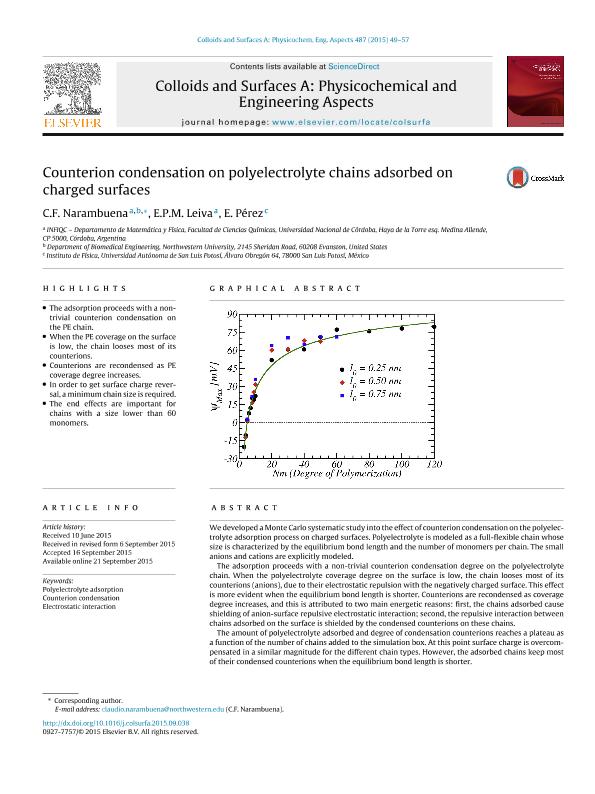Mostrar el registro sencillo del ítem
dc.contributor.author
Narambuena, Claudio Fabian

dc.contributor.author
Leiva, Ezequiel Pedro M.

dc.contributor.author
Pérez, Elías
dc.date.available
2018-06-05T19:51:33Z
dc.date.issued
2015-09-20
dc.identifier.citation
Narambuena, Claudio Fabian; Leiva, Ezequiel Pedro M.; Pérez, Elías; Counterion condensation on polyelectrolyte chains adsorbed on charged surfaces; Elsevier Science; Colloids and Surfaces A: Physicochemical and Engineering Aspects; 487; 20-9-2015; 49-57
dc.identifier.issn
0927-7757
dc.identifier.uri
http://hdl.handle.net/11336/47377
dc.description.abstract
We developed a Monte Carlo systematic study into the effect of counterion condensation on the polyelectrolyte adsorption process on charged surfaces. Polyelectrolyte is modeled as a full-flexible chain whose size is characterized by the equilibrium bond length and the number of monomers per chain. The small anions and cations are explicitly modeled. The adsorption proceeds with a non-trivial counterion condensation degree on the polyelectrolyte chain. When the polyelectrolyte coverage degree on the surface is low, the chain looses most of its counterions (anions), due to their electrostatic repulsion with the negatively charged surface. This effect is more evident when the equilibrium bond length is shorter. Counterions are recondensed as coverage degree increases, and this is attributed to two main energetic reasons: first, the chains adsorbed cause shielding of anion-surface repulsive electrostatic interaction; second, the repulsive interaction between chains adsorbed on the surface is shielded by the condensed counterions on these chains. The amount of polyelectrolyte adsorbed and degree of condensation counterions reaches a plateau as a function of the number of chains added to the simulation box. At this point surface charge is overcompensated in a similar magnitude for the different chain types. However, the adsorbed chains keep most of their condensed counterions when the equilibrium bond length is shorter. Additionally, we study the size effect (number of monomer per chain) on the condensation degree on adsorbed polyelectrolyte. Condensation is highly dependent on a low chain size (low than 60 monomers approximately) since end effects are important. With a higher chain size, counterion condensation and charge reversal show a negligible correlation with chain size.
dc.format
application/pdf
dc.language.iso
eng
dc.publisher
Elsevier Science

dc.rights
info:eu-repo/semantics/openAccess
dc.rights.uri
https://creativecommons.org/licenses/by-nc-sa/2.5/ar/
dc.subject
Polyelectrolyte Adsorption
dc.subject
Counterion Condensation
dc.subject
Electrostatic Interaction
dc.subject.classification
Otras Ciencias Químicas

dc.subject.classification
Ciencias Químicas

dc.subject.classification
CIENCIAS NATURALES Y EXACTAS

dc.title
Counterion condensation on polyelectrolyte chains adsorbed on charged surfaces
dc.type
info:eu-repo/semantics/article
dc.type
info:ar-repo/semantics/artículo
dc.type
info:eu-repo/semantics/publishedVersion
dc.date.updated
2018-05-07T18:04:32Z
dc.journal.volume
487
dc.journal.pagination
49-57
dc.journal.pais
Países Bajos

dc.journal.ciudad
Amsterdam
dc.description.fil
Fil: Narambuena, Claudio Fabian. Consejo Nacional de Investigaciones Científicas y Técnicas. Centro Científico Tecnológico Conicet - Córdoba. Instituto de Investigaciones en Físico-química de Córdoba. Universidad Nacional de Córdoba. Facultad de Ciencias Químicas. Instituto de Investigaciones en Físico-química de Córdoba; Argentina. Northwestern University; Estados Unidos
dc.description.fil
Fil: Leiva, Ezequiel Pedro M.. Consejo Nacional de Investigaciones Científicas y Técnicas. Centro Científico Tecnológico Conicet - Córdoba. Instituto de Investigaciones en Físico-química de Córdoba. Universidad Nacional de Córdoba. Facultad de Ciencias Químicas. Instituto de Investigaciones en Físico-química de Córdoba; Argentina
dc.description.fil
Fil: Pérez, Elías. Instituto de Física, Universidad Autónoma de San Luis Potosí; México
dc.journal.title
Colloids and Surfaces A: Physicochemical and Engineering Aspects

dc.relation.alternativeid
info:eu-repo/semantics/altIdentifier/url/https://www.sciencedirect.com/science/article/pii/S0927775715302260
dc.relation.alternativeid
info:eu-repo/semantics/altIdentifier/doi/http://dx.doi.org/10.1016/j.colsurfa.2015.09.038
Archivos asociados
